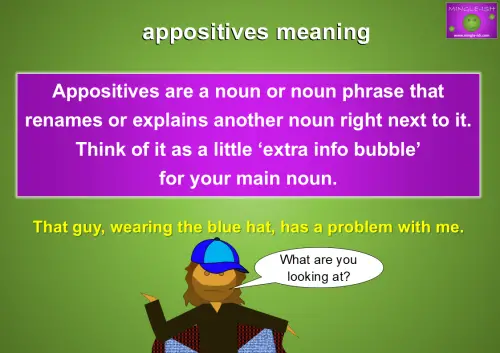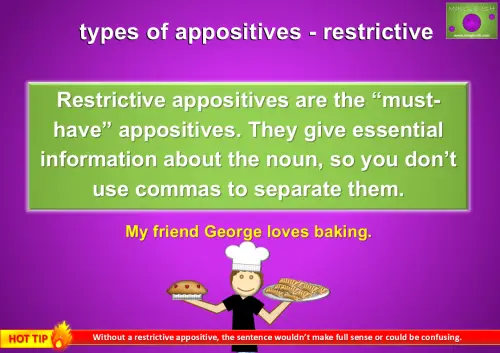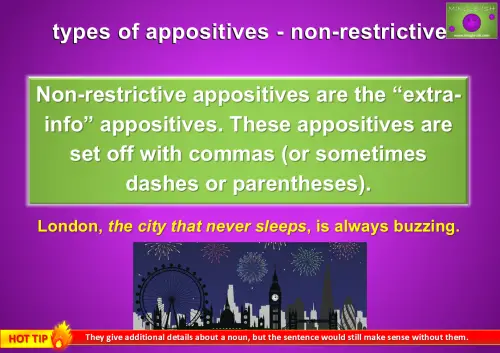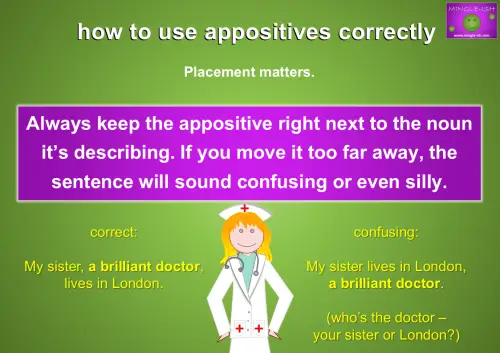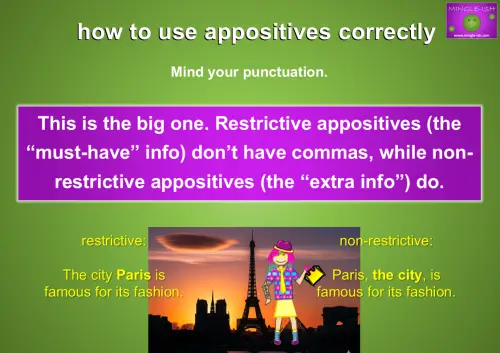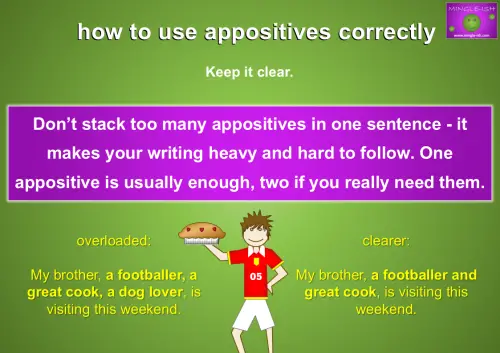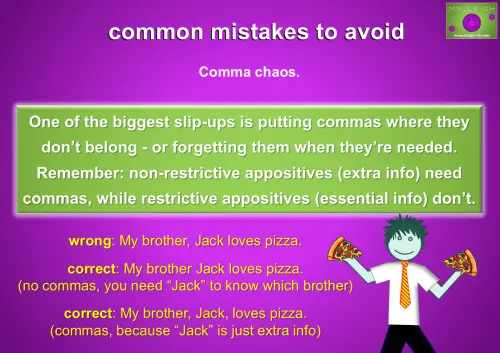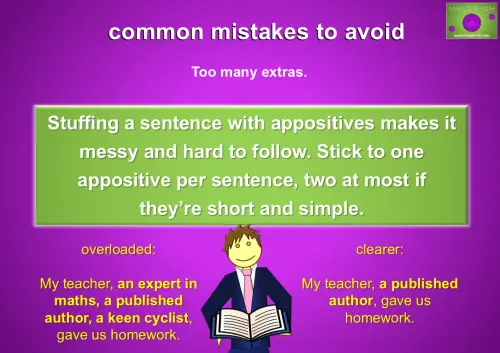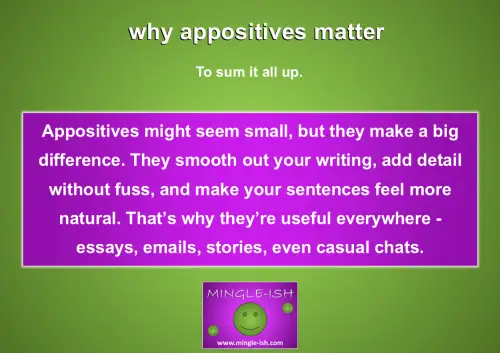Appositives are a simple but powerful part of English grammar. They show up everywhere in writing and speech, so learning them is really useful. For ESL and EFL learners, getting to grips with appositives can make sentences smoother, clearer, and more natural. On this page, you’ll find everything you need to start using them with confidence.
What is an appositive?
I’m guessing you’ve never heard of an appositive before. It’s not one of the first grammar topics you learn when starting to learn English. I bet you’ve seen them before but didn’t know they had a name. An appositive is basically a bit more information to add to an existing noun.
Appositives are a noun or noun phrase that renames or explains another noun right next to it. Think of it as a little ‘extra info bubble’ for your main noun.
For example:
My dog, a tiny black pug, loves to nap on the sofa.
Here, “a tiny black pug” tells us more about “my dog.”
Most appositives sit right next to the noun they describe and often come with punctuation like commas, dashes, or parentheses.
Types of Appositives
Not all appositives are the same—some are essential, some are just extra, and each type has its own rules. Let’s delve a little deeper and take a look.
Restrictive Appositives
Restrictive appositives are the “must-have” appositives. They give essential information about the noun, so you don’t use commas to separate them. Without a restrictive appositive, the sentence wouldn’t make full sense or could be confusing.
For example:
- The author J.K. Rowling wrote Harry Potter.
- My friend Sophie loves hiking.
- The city Paris is famous for its cafes.
In each case, the appositive is crucial—without it, we wouldn’t know which author, friend, or city we’re talking about.
Hot tip: If you can’t remove the appositive without changing the meaning of the sentence, it’s restrictive.
Non-Restrictive Appositives
Non-restrictive appositives are the “extra-info” appositives. They give additional details about a noun, but the sentence would still make sense without them. These appositives are set off with commas (or sometimes dashes or parentheses).
For example:
- My dog, a tiny black pug, loves to nap on the sofa.
- London, the city that never sleeps, is always buzzing.
- Sarah, my childhood neighbour, moved abroad last year.
In each case, the appositive adds flavour or detail, but the main sentence still works on its own.
Hot tip: If you can remove the appositive and the sentence still makes sense, it’s non-restrictive.
How to Use Appositives Correctly
Appositives aren’t difficult, but there are a few golden rules that will keep your sentences neat and easy to read. Follow these tips and you’ll be using them like a pro:
Placement matters
Always keep the appositive right next to the noun it’s describing. If you move it too far away, the sentence will sound confusing or even silly.
- Correct: My sister, a brilliant doctor, lives in London.
- Confusing: My sister lives in London, a brilliant doctor. (who’s the doctor—your sister or London?)
Mind your punctuation
This is the big one. Restrictive appositives (the “must-have” info) don’t have commas, while non-restrictive appositives (the “extra info”) do.
- Restrictive: The city Paris is famous for its fashion.
- Non-restrictive: Paris, the city, is famous for its fashion.
Keep it clear
Don’t stack too many appositives in one sentence—it makes your writing heavy and hard to follow. One appositive is usually enough, two if you really need them.
- Overloaded: My brother, a footballer, a great cook, a dog lover, is visiting this weekend.
- Clearer: My brother, a footballer and great cook, is visiting this weekend.
Hot tip: If you’re ever unsure, read the sentence out loud. If it feels clunky or confusing, simplify it. Appositives are supposed to make writing smoother, not harder to understand.
Common Mistakes to Avoid
Even though appositives are pretty simple, there are a few traps that learners (and even native speakers) often fall into. Watch out for these common mistakes so your sentences stay clear and professional.
Comma chaos
One of the biggest slip-ups is putting commas where they don’t belong—or forgetting them when they’re needed. Remember: non-restrictive appositives (extra info) need commas, while restrictive appositives (essential info) don’t.
- Wrong: My brother, Jack loves pizza.
- Correct: My brother Jack loves pizza. (no commas, because you need “Jack” to know which brother)
- Correct: My brother, Jack, loves pizza. (commas, because “Jack” is just extra info)
Too many extras
Stuffing a sentence with appositives makes it messy and hard to follow. Stick to one appositive per sentence, two at most if they’re short and simple.
- Overloaded: My teacher, an expert in maths, a published author, a keen cyclist, gave us homework.
- Clearer: My teacher, a published author, gave us homework.
Mixing them up
Appositives aren’t the same as adjectives or clauses. An adjective describes a noun (e.g. a red car), and a relative clause gives more detail with “who/that/which” (e.g. the car that I bought). Appositives, on the other hand, rename or explain the noun right next to them.
- Appositive: My car, a second-hand Toyota, is very reliable.
- Adjective: My red car is very reliable.
- Relative clause: My car, which I bought second-hand, is very reliable.
Hot tip: If the extra detail can replace the noun, it’s an appositive.
Why Appositives Matter
Appositives might seem small, but they make a big difference. They smooth out your writing, add detail without fuss, and make your sentences feel more natural. That’s why they’re useful everywhere—essays, emails, stories, even casual chats.
Real-life examples:
- Essay: William Shakespeare, one of the greatest playwrights in history, shaped English literature.
- Email: I spoke to Sarah, our project manager, about the new deadline.
- Casual chat: I’m meeting Ben, my gym buddy, later for a coffee.
See how each appositive drops in helpful info without slowing the sentence down? Mastering this little grammar tool makes your English clearer, smoother, and more polished without extra effort. Appositives are especially helpful for ESL and EFL learners, because they add clarity, variety, and confidence to everyday writing.
Test Your Knowledge with These Appositives Quizzes
Think you’ve mastered appositives? Take these fun quizzes to check your understanding and see how well you can spot and use them in sentences. Once you’ve finished, head over to my YouTube channel for more quick grammar lessons and quizzes to keep improving your English every day!
Related Grammar Topics
If you’re enjoying appositives and want to keep boosting your grammar skills, why stop here? Check out these other helpful guides in my grammar section: adjectives, punctuation rules, and sentence structure. Each one is packed with simple explanations and examples to make English easier.
If you prefer learning with videos, come join me over on my YouTube channel where I share fun grammar quizzes and lessons to keep your English sharp and engaging.
Conclusion
Ready to take your writing up a notch? Start noticing appositives in books, articles, or even everyday conversations, and then have a go at adding them into your own sentences. It’s a simple trick that makes your English sound clearer and more natural.
Want more easy grammar tips and fun quizzes? Keep exploring the site and don’t forget to check out my YouTube channel for videos that make learning English engaging and practical. Your English will thank you!
